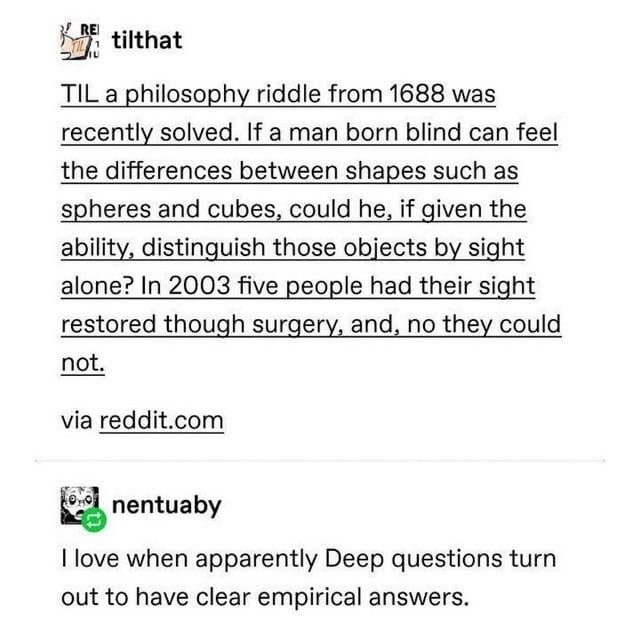this post was submitted on 21 Oct 2023
1046 points (98.5% liked)
Microblog Memes
5846 readers
1737 users here now
A place to share screenshots of Microblog posts, whether from Mastodon, tumblr, ~~Twitter~~ X, KBin, Threads or elsewhere.
Created as an evolution of White People Twitter and other tweet-capture subreddits.
Rules:
- Please put at least one word relevant to the post in the post title.
- Be nice.
- No advertising, brand promotion or guerilla marketing.
- Posters are encouraged to link to the toot or tweet etc in the description of posts.
Related communities:
founded 1 year ago
MODERATORS
you are viewing a single comment's thread
view the rest of the comments
view the rest of the comments

There are different kinds of tactile cells present both in the human skin as well as in the human tongue. Among those are nociceptors, Merkel-Ranvier cells and Meissner's corpuscles. While the density may vary, e.g., Merkel-Ravier cells are concentrated in the finger tips, those are still contributing to similar sensations wherever you have them. Those are not new sensory "devices" which are suddenly attached to your brain. Your brain is already familiar with inputs from those cells and has learned to interpret their signal patterns. This is why I would say that it's not challenging for you to imagine the perception of texture on your tongue, even though you mainly felt it on your skin before. You can also imagine feeling a similar texture of an object on your arm, even if you just touched it with your feet or hands before. Taste, however, is something different. You probably licked a rock or two when you were an infant or child, and tasted and smelled a lot of the world surrounding you. That's why you might even be able to imagine the taste of objects to a certain degree. (Of course, this becomes more difficult the more complex the taste is and depends on your exposure on different taste components and associations with objects where you typically find those.)
Getting sight at some point later in life, while being born blind, is like plugging in a new sensory device to your brain. It needs time to learn how to interpret the input signals, but after some time of training, it will be able to distinguish colors, shapes, objects, etc.. Having sight is nothing a blind person can relate to via other sensory information in any way, since sight is entirely depending on functional eyes (and specific neural pathways in the brain).
A good example of how the brain adapts to such new sensory inputs is Neil Harbisson.
This is a guy who has a colour-blindness and got a brain implant which coded colour into sound waves, such that he can "hear" colours. After some time of adapting he even started to dream colours as sounds.
https://www.bbc.com/news/av/technology-29992577
https://www.youtube.com/watch?v=mc2fOI9vLzo
Yeah, I'm thinking of it kinda like machine learning. To be able to do something like pick a visual thing to match a tactile thing... you need to have had other tactile<->visual experiences. Knowing what a shark edge looks like or feels like requires you to have touched or seen an object with such qualities. Given enough examples, you can generalize, and make estimations about things you've never touched or seen, but we're not born with any of that.